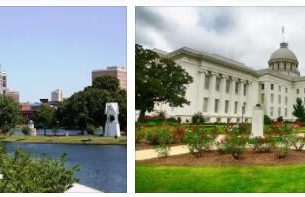Geography of Escambia County, Alabama
Located in the southwestern corner of Alabama, Escambia County is a region characterized by its diverse natural landscapes, including rolling hills, fertile plains, and winding waterways. From the banks of the Conecuh River to the expansive forests of the Conecuh National Forest, Escambia County offers residents and visitors alike a rich tapestry of geography, climate, and outdoor recreational opportunities. Check allunitconverters to learn more about the state of Alabama.
Physical Features:
- Conecuh River: The Conecuh River is one of the primary waterways in Escambia County, flowing through the heart of the region and shaping its landscape. Originating in southern Alabama, the Conecuh River meanders northward through Escambia County before eventually joining the Alabama River. The river is known for its scenic beauty, abundant wildlife, and recreational opportunities, including fishing, boating, and kayaking. The Conecuh River also serves as an important habitat for various species of fish, birds, and other wildlife.
- Conecuh National Forest: The Conecuh National Forest covers a significant portion of Escambia County, encompassing over 83,000 acres of diverse ecosystems, including pine forests, hardwood swamps, and open grasslands. The national forest provides habitat for a variety of plant and animal species, including white-tailed deer, wild turkeys, and endangered red-cockaded woodpeckers. Outdoor enthusiasts can explore the forest’s extensive network of hiking trails, scenic overlooks, and camping areas, as well as participate in activities such as hunting, fishing, birdwatching, and horseback riding.
- Geological Formations: Escambia County is situated on the Gulf Coastal Plain, a relatively flat region characterized by its sandy soils, limestone outcroppings, and karst topography. The county’s geology is shaped by millions of years of sedimentation, erosion, and tectonic activity, resulting in a variety of geological formations, including sinkholes, caves, and underground aquifers. These geological features play a critical role in the region’s hydrology, providing sources of freshwater for drinking, agriculture, and industry.
Climate:
Escambia County experiences a humid subtropical climate, characterized by hot, humid summers and mild, relatively dry winters. The region’s climate is influenced by its proximity to the Gulf of Mexico, as well as its inland location and elevation.
Summers in Escambia County are typically hot and humid, with daytime temperatures often reaching into the 90s Fahrenheit. Humidity levels can be high, especially during the summer months, making it feel even hotter. Thunderstorms are common during the summer afternoons and evenings, bringing heavy rain, lightning, and gusty winds.
Winters in Escambia County are generally mild, with daytime temperatures ranging from the 50s to the 60s Fahrenheit. Nighttime temperatures can drop below freezing occasionally, especially during cold fronts or Arctic air masses. Snowfall is rare in Escambia County, with only a few inches of snow accumulating on the ground every few years.
Human Impact:
- Agriculture: Agriculture has long been a cornerstone of the economy in Escambia County, with farmers cultivating crops such as peanuts, cotton, soybeans, and corn. The county’s fertile soils, warm climate, and abundant water resources support a diverse range of agricultural practices, from row crop farming to livestock production. Agriculture contributes significantly to the local economy, providing jobs, income, and food for residents and consumers across the region.
- Timber Industry: The timber industry is another important sector of the economy in Escambia County, with vast forests covering much of the region. The county’s forests are dominated by pine trees, which are harvested for lumber, paper, and other wood products. Timber harvesting provides jobs, income, and tax revenue for residents and communities across the county, although it also raises concerns about environmental degradation, habitat loss, and wildlife management.
- Industry: Industry plays a smaller role in the economy of Escambia County, with manufacturing, healthcare, and retail trade being the primary sectors. The county is home to several industrial facilities, including paper mills, textile factories, and food processing plants. These industries provide jobs, income, and tax revenue for residents and communities across the county, although they also raise concerns about environmental pollution, public health, and safety.
Conservation Efforts:
Efforts to conserve and protect Escambia County’s natural resources are ongoing, with a focus on preserving sensitive habitats, managing water resources sustainably, and promoting responsible land use practices. Conservation organizations, such as the Alabama Department of Conservation and Natural Resources and the Nature Conservancy, work to protect critical ecosystems, restore degraded habitats, and enhance wildlife habitat. Efforts to address issues such as habitat loss, water pollution, and climate change are also underway, with initiatives to promote conservation practices, reduce greenhouse gas emissions, and increase public awareness and engagement.
Conclusion:
In conclusion, Escambia County, Alabama, offers a diverse array of natural landscapes, outdoor recreational opportunities, and economic resources for residents and visitors alike. From the winding waters of the Conecuh River to the sprawling forests of the Conecuh National Forest, the county boasts a rich tapestry of geography, climate, and culture. While facing challenges such as agriculture, timber harvesting, and industrial development, Escambia County remains a resilient and vibrant community with a deep connection to its land and heritage. Through collaboration, innovation, and conservation efforts, the county continues to balance economic growth with the protection of its unique landscapes and ecosystems, ensuring a sustainable future for generations to come.


